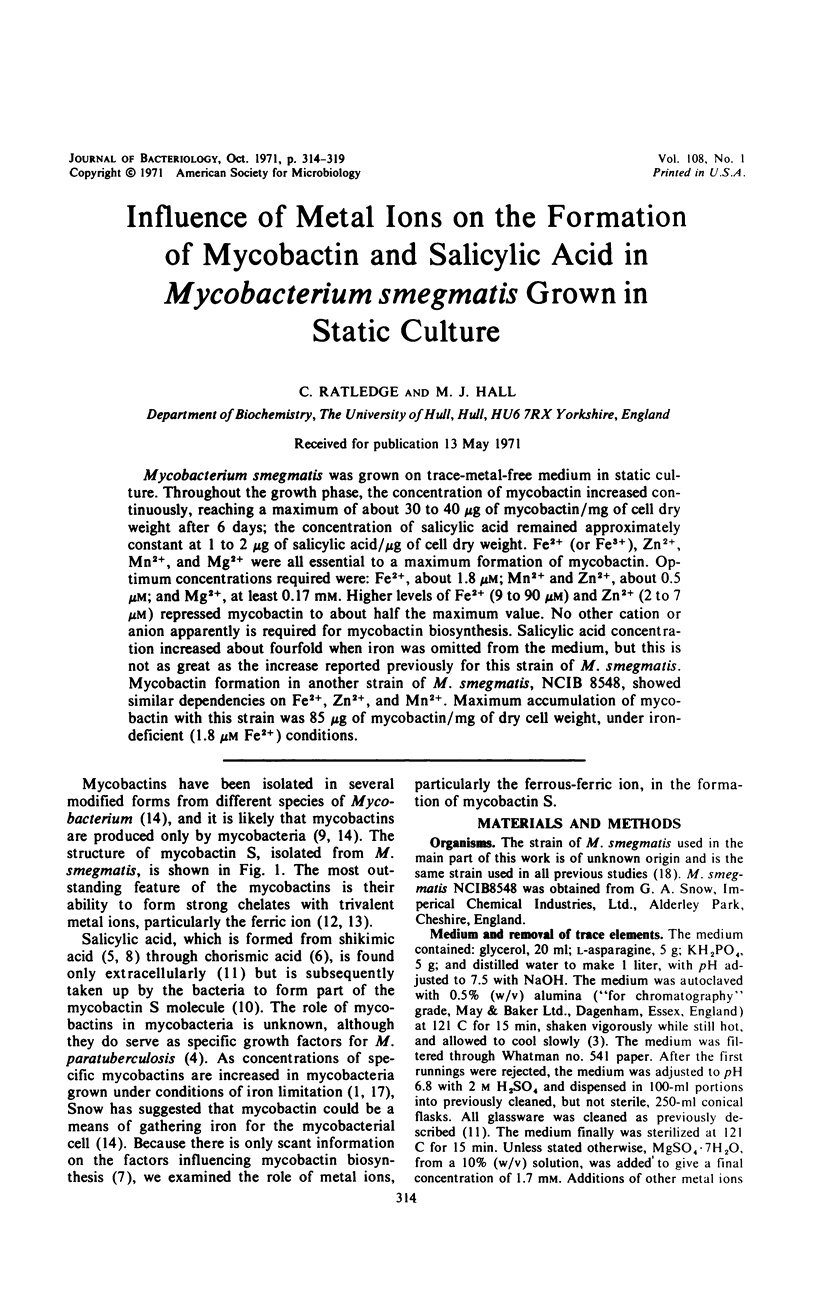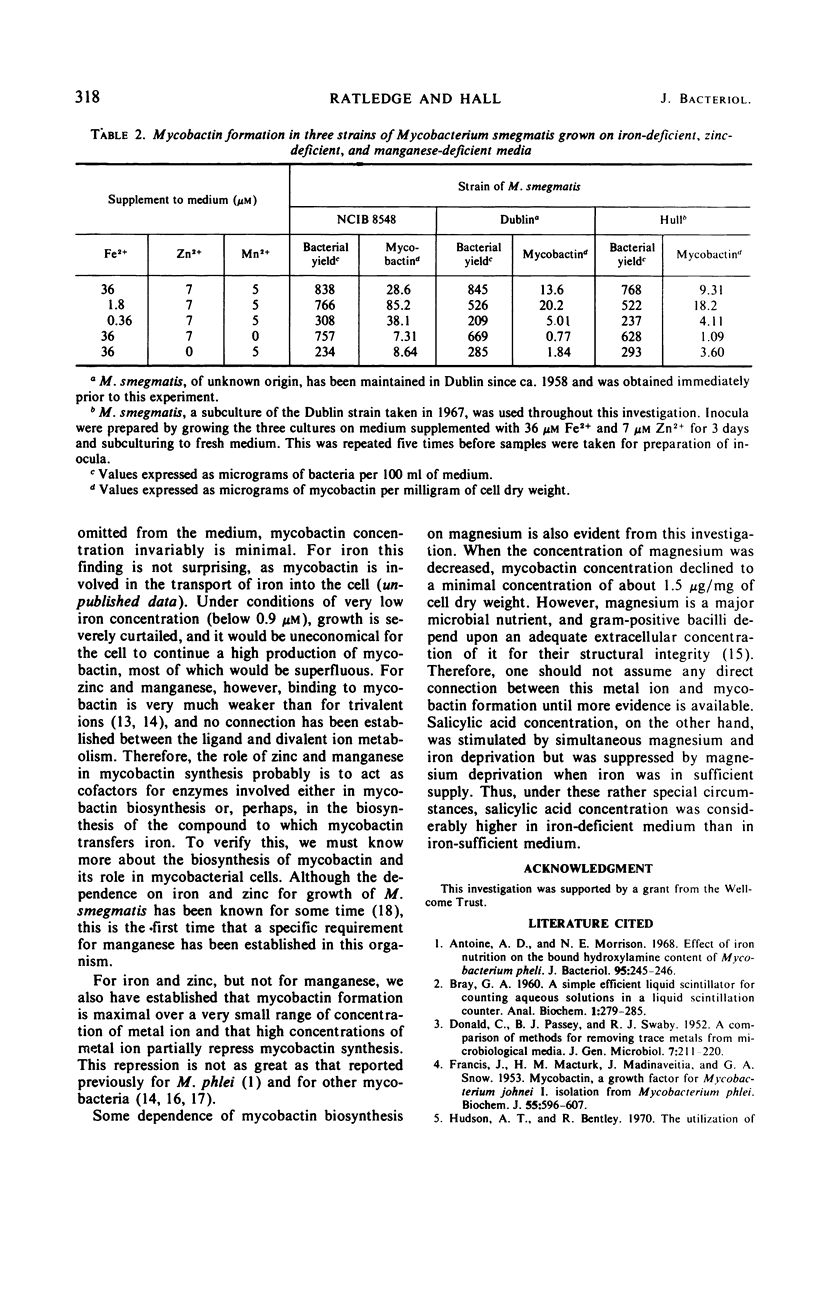Abstract
Mycobacterium smegmatis was grown on trace-metal-free medium in static culture. Throughout the growth phase, the concentration of mycobactin increased continuously, reaching a maximum of about 30 to 40 μg of mycobactin/mg of cell dry weight after 6 days; the concentration of salicylic acid remained approximately constant at 1 to 2 μg of salicylic acid/μg of cell dry weight. Fe2+ (or Fe3+), Zn2+, Mn2+, and Mg2+ were all essential to a maximum formation of mycobactin. Optimum concentrations required were: Fe2+, about 1.8 μm; Mn2+ and Zn2+, about 0.5 μm; and Mg2+, at least 0.17 mm. Higher levels of Fe2+ (9 to 90 μm) and Zn2+ (2 to 7 μm) repressed mycobactin to about half the maximum value. No other cation or anion apparently is required for mycobactin biosynthesis. Salicylic acid concentration increased about fourfold when iron was omitted from the medium, but this is not as great as the increase reported previously for this strain of M. smegmatis. Mycobactin formation in another strain of M. smegmatis, NCIB 8548, showed similar dependencies on Fe2+, Zn2+, and Mn2+. Maximum accumulation of mycobactin with this strain was 85 μg of mycobactin/mg of dry cell weight, under iron-deficient (1.8 μm Fe2+) conditions.
Full text
PDF





Selected References
These references are in PubMed. This may not be the complete list of references from this article.
- Antoine A. D., Morrison N. E. Effect of iron nutrition on the bound hydroxylamine content of Mycobacterium phlei. J Bacteriol. 1968 Jan;95(1):245–246. doi: 10.1128/jb.95.1.245-246.1968. [DOI] [PMC free article] [PubMed] [Google Scholar]
- DONALD C., PASSEY B. I., SWABY R. J. A comparison of methods for removing trace metals from microbiological media. J Gen Microbiol. 1952 Nov;7(3-4):211–220. doi: 10.1099/00221287-7-3-4-211. [DOI] [PubMed] [Google Scholar]
- FRANCIS J., MACTURK H. M., MADINAVEITIA J., SNOW G. A. Mycobactin, a growth factor for Mycobacterium johnei. I. Isolation from Mycobacterium phlei. Biochem J. 1953 Nov;55(4):596–607. doi: 10.1042/bj0550596. [DOI] [PMC free article] [PubMed] [Google Scholar]
- Hudson A. T., Bentley R. Utilization of shikimic acid for the formation of mycobactin S and salicylic acid by Mycobacterium smegmatis. Biochemistry. 1970 Sep 29;9(20):3984–3987. doi: 10.1021/bi00822a017. [DOI] [PubMed] [Google Scholar]
- Marshall B. J., Ratledge C. Conversion of chorismic acid and isochorismic acid to salicylic acid by cell-free extracts of Mycobacterium smegmatis. Biochim Biophys Acta. 1971;230(3):643–645. doi: 10.1016/0304-4165(71)90201-7. [DOI] [PubMed] [Google Scholar]
- RATLEDGE C., WINDER F. G. The accumulation of salicylic acid by mycobacteria during growth on an iron-deficient medium. Biochem J. 1962 Sep;84:501–506. doi: 10.1042/bj0840501. [DOI] [PMC free article] [PubMed] [Google Scholar]
- Ratledge C., Chaudhry M. A. Accumulation of iron-binding phenolic acids by Actinomycetales and other organisms related to the Mycobacteria. J Gen Microbiol. 1971 Apr;66(1):71–78. doi: 10.1099/00221287-66-1-71. [DOI] [PubMed] [Google Scholar]
- Ratledge C., Hall M. J. Uptake of salicylic acid into mycobactin S by growing cells of Mycobacterium smegmatis. FEBS Lett. 1970 Oct;10(5):309–312. doi: 10.1016/0014-5793(70)80460-4. [DOI] [PubMed] [Google Scholar]
- Ratledge C. Some factors influencing mycobactin and salicylic acid production in Mycobacterium smegmatis. Biochem J. 1968 Nov;110(2):23P–23P. doi: 10.1042/bj1100023p. [DOI] [PMC free article] [PubMed] [Google Scholar]
- Ratledge C. The biosynthesis of salicylic acid in Mycobacterium smegmatis via the shikimic acid pathway. Biochim Biophys Acta. 1969 Oct 7;192(1):148–150. doi: 10.1016/0304-4165(69)90023-3. [DOI] [PubMed] [Google Scholar]
- SNOW G. A. THE STRUCTURE OF MYCOBACTIN P, A GROWTH FACTOR FOR MYCOBACTERIUM JOHNEI, AND THE SIGNIFICANCE OF ITS IRON COMPLEX. Biochem J. 1965 Jan;94:160–165. doi: 10.1042/bj0940160. [DOI] [PMC free article] [PubMed] [Google Scholar]
- Snow G. A. Metal complexes of mycobactin P and of desferrisideramines. Biochem J. 1969 Nov;115(2):199–205. doi: 10.1042/bj1150199. [DOI] [PMC free article] [PubMed] [Google Scholar]
- Snow G. A. Mycobactins: iron-chelating growth factors from mycobacteria. Bacteriol Rev. 1970 Jun;34(2):99–125. doi: 10.1128/br.34.2.99-125.1970. [DOI] [PMC free article] [PubMed] [Google Scholar]
- WINDER F., DENNENY J. M. Effect of iron and zinc on nucleic acid and protein synthesis in Mycobacterium smegmatis. Nature. 1959 Aug 29;184(Suppl 10):742–743. doi: 10.1038/184742a0. [DOI] [PubMed] [Google Scholar]
- Webb M. Effects of magnesium deficiency on ribosomal structure and function in certain Gram-positive and Gram-negative bacteria. Biochim Biophys Acta. 1970 Nov 24;222(2):416–427. doi: 10.1016/0304-4165(70)90132-7. [DOI] [PubMed] [Google Scholar]
- White A. J., Snow G. A. Isolation of mycobactinss from various mycobacteria. The properties of mycobactin S and H. Biochem J. 1969 Mar;111(5):785–792. doi: 10.1042/bj1110785. [DOI] [PMC free article] [PubMed] [Google Scholar]
- White A. J., Snow G. A. Methods for the separation and identification of mycobactins from various species of mycobacteria. Biochem J. 1968 Jul;108(4):593–597. doi: 10.1042/bj1080593. [DOI] [PMC free article] [PubMed] [Google Scholar]


